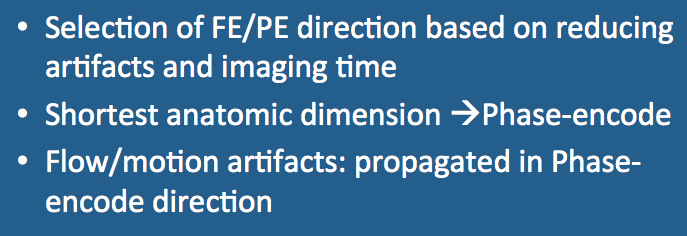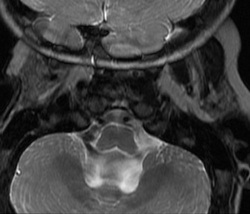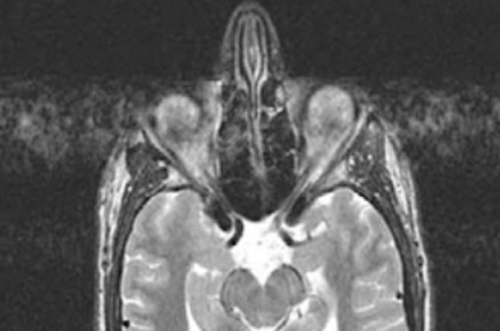Three factors are considered in selecting phase- and frequency-encode directions: 1) reducing artifacts, 2) minimizing scanning time, and 3) accommodating restrictions imposed by coil design or parallel imaging.
|
The phase-encoding direction is associated with two major artifacts: wrap-around and flow/motion. Wrap-around (also called aliasing) occurs when the size of the body part imaged exceeds the defined field-of-view (FOV) in the phase-encode direction. This causes anatomy outside the FOV to be folded in over the main part of the image. Although methods exist to overcome this artifact (phase-oversampling) they require additional phase-encoding measurements to be made and hence incur an imaging time penalty. As a rule, therefore, to avoid wrap-around the phase-encoding direction is usually chosen to be along the shortest anatomic dimension.
|
Flow and motion artifacts are also propagated predominantly in the phase-encode direction. Moving anatomic structures often producing problematic artifacts during MR imaging include the eyes, pharynx (swallowing), heart, lungs, diaphragm, and upper abdominal organs. The phase-encoding direction is usually chosen so that these artifacts do not project over the area of interest. For example, axial brain images are usually phase-encoded from left to right so that artifacts from the eyes do not spill over into the brain.
Artifacts from pulsatile blood flow behave in a similar fashion and are propagated along the phase-encoding axis. Arterial pulsations from the heart and aorta are particularly problematic, but flow artifacts may occur from any vessel, even large veins. Appropriate choice of phase- and frequency-encoding directions will not eliminate these artifacts but will move them off the area of interest.
Susceptibility artifacts due to metal objects often produce image distortions and degradation. Here it may be impossible to predict in advance which direction for phase- or frequency-encoding is optimal. Trial and error may be necessary. I have been pleasantly surprised on numerous occasions that by simply swapping phase- and frequency-encoding directions empirically, very severe susceptibility artifacts may be reduced or moved away from from the area of interest.
Minimizing scanning time is also a consideration when selecting phase- and frequency-encode directions. This is especially important for 3D acquisitions where one of the two phase-encoding directions is used for slice-selection. More phase encode steps require more imaging time so it is important to make sure the principle slice-select direction is along the shortest anatomic dimension. In 3D spine imaging, for example, where long rectangular 3D volumes are used, the principal slice-select direction is always chosen to be in the sagittal plane to minimize imaging time.
Finally, coil design and parallel imaging considerations may impose limitations on choice of phase-encode direction. For example, in total spine imaging using multiple surface coils arrayed from superiorly to inferiorly, only the anterior-posterior or left-right directions may be used for phase-encoding as a restriction imposed by the parallel imaging technique.
Advanced Discussion (show/hide)»
No supplementary material yet. Check back soon!
References
Stadler A, Schima W, Ba-Ssalamah A et al. Artifacts in body MR imaging: their appearance and how to eliminate them. Eur Radiol 2007; 17:1242-1255.
Stadler A, Schima W, Ba-Ssalamah A et al. Artifacts in body MR imaging: their appearance and how to eliminate them. Eur Radiol 2007; 17:1242-1255.



